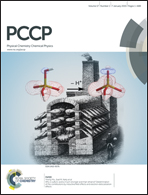A green approach to offset the perturbation action of 1-butyl-3-methylimidazolium iodide on α-chymotrypsin†
Abstract
Recently, studies have provided evidence for the negative effects of ionic liquids (ILs), “greener solvents,” on proteins [Phys. Chem. Chem. Phys., 2014, 16, 5514]. The search to offset the negative effects of ILs on proteins has come into limelight as the maintenance of a “green solvent medium” is a great challenge for chemists and biochemists. As the first step in this search, 1-butyl-3-methylimidazolium bromide ([Bmim][Br]) has been applied to offset the deleterious action of 1-butyl-3-methylimidazolium iodide ([Bmim][I]) on α-chymotrypsin (CT). Fluorescence and circular dichroism (CD) experiments results have indicated that [Bmim][Br] significantly offsets the deleterious action of [Bmim][I] at lower concentrations (0.025 M). Surprisingly, the stabilizing action of [Bmim][Br] turns into a deleterious action for CT at higher concentrations (>0.1 M). On the other hand, [Bmim][I] acted as a destabilizer for CT at all investigated concentrations (0.025–0.6 M). The results obtained from this study lead to valuable insights into the selection of suitable ILs to attenuate the deleterious action of another IL without disturbing the protein structure.


 Please wait while we load your content...
Please wait while we load your content...